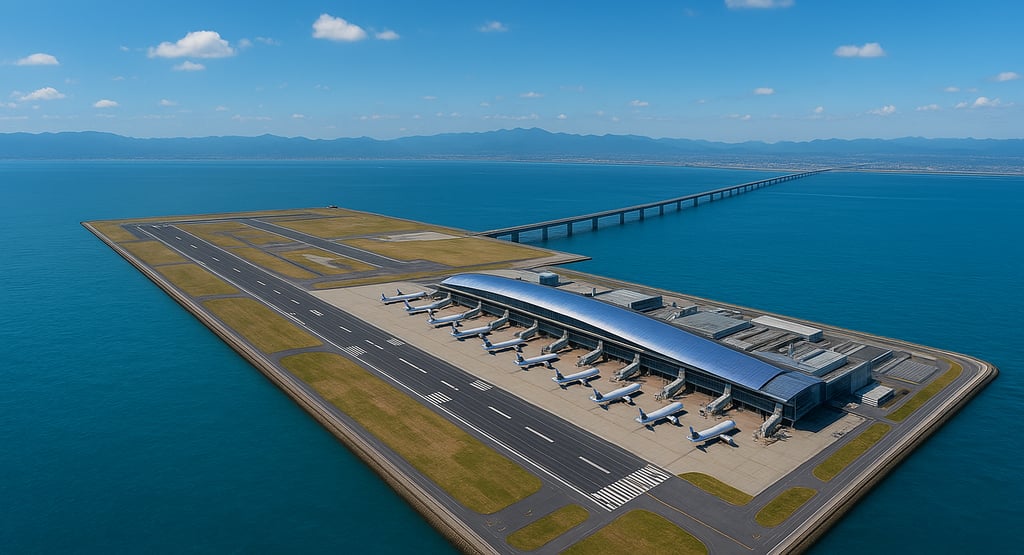The First Ocean Airport in Japan: Kansai International Airport (KIX)
When Japan unveiled Kansai International Airport (KIX) in 1994, the world watched in awe. Built entirely on an artificial island in Osaka Bay, KIX was not only the first ocean airport in Japan but also one of the most ambitious civil engineering projects ever undertaken. This floating marvel defied geographic limitations and responded to Japan's critical need for space, becoming a global model for offshore airport construction. Today, KIX stands as more than a transport hub—it represents Japanese innovation, resilience, and vision. Whether you're an aviation enthusiast, a curious traveler, or an admirer of modern infrastructure, Kansai International Airport offers a fascinating story worth telling.
5/12/20253 min read
Why Build an Airport in the Ocean?
Japan's geographical reality is complex. The country is mountainous, densely populated, and prone to natural disasters like earthquakes and typhoons. By the 1980s, the existing Osaka International Airport (Itami) had reached its limit in capacity and was increasingly encroaching on residential areas, prompting complaints over noise and environmental impact.
Instead of expanding inland, Japanese engineers proposed an extraordinary idea: build an entirely new airport in the middle of the sea. This would:
Reduce noise pollution for residents.
Allow 24-hour operation (which Itami couldn’t offer).
Create room for future expansion without affecting city life.
Serve as a gateway to the Kansai region, including Kyoto, Nara, and Kobe.
Thus, the concept of Kansai International Airport was born.
Building the Unthinkable: Engineering Feats and Challenges
Artificial Island Creation
The first step was creating a 4-kilometer-long and 1.25-kilometer-wide man-made island. Located about 5 kilometers offshore, the island required an enormous amount of landfill—about 21 million cubic meters of rock and earth from nearby mountains.
Engineers had to account for soft seabed conditions, which meant the island would inevitably sink. They estimated it would subside by about 5.7 meters over 50 years. Despite their calculations, the actual rate of subsidence surprised everyone, requiring emergency engineering adjustments during and after construction.
Earthquake and Typhoon Resistance
Japan’s seismic activity demanded that KIX be earthquake-resistant, a tall order for a floating airport. To address this, the terminal and runways were built on giant flexible columns and shock-absorbing joints. The airport also had to withstand typhoon winds and tidal surges, with a 3-kilometer-long seawall protecting the perimeter.
Terminal Design by Renzo Piano
The crown jewel of the project is the Terminal 1 building, designed by acclaimed Italian architect Renzo Piano. At 1.7 kilometers long, it was the longest airport terminal in the world upon completion. With its sleek, aerodynamic shape and natural light-filled interior, the terminal is a visual and functional masterpiece, designed to allow passengers to flow smoothly from check-in to boarding.
Grand Opening and Early Days
Kansai International Airport officially opened on September 4, 1994. The inaugural flight, a Japan Airlines (JAL) 747, departed for London, marking the start of a new era in Japanese aviation. The airport quickly gained attention worldwide for its advanced infrastructure, beauty, and seamless integration of technology.
In its early years, KIX faced high operating costs and fierce competition from Tokyo's Narita Airport. However, it steadily grew in popularity thanks to its 24-hour status and ideal location for international connections to China, Korea, Southeast Asia, and Australia.
KIX Today: More Than an Airport
Today, Kansai International Airport is a major international hub, handling over 30 million passengers annually (pre-COVID-19 levels). It serves as a key entry point for visitors exploring:
Osaka’s vibrant street food and nightlife
Kyoto’s temples and traditional culture
Kobe’s cosmopolitan charm
Nara’s historical sites
It has expanded with a second runway and Terminal 2, catering mainly to low-cost carriers. There's even a hotel, shopping complex, observation deck, and cultural exhibits on site.
A Symbol of Resilience: Typhoon Jebi and Recovery
In 2018, Kansai Airport faced one of its greatest challenges when Typhoon Jebi struck the region. A storm surge flooded the runways, and a fuel tanker collided with the bridge connecting the island to the mainland, cutting off access.
Despite severe damage, the airport recovered quickly, partially reopening within days and resuming most operations within a month. This resilience further cemented KIX’s status as a modern engineering marvel capable of withstanding the elements.
Travel Tips for Visitors Using KIX
If you're flying to or from Kansai International Airport, here are a few useful tips to enhance your experience:
1. Transportation
Airport Express (Haruka): Direct trains to Kyoto and Osaka.
Nankai Airport Line: Affordable and fast option to downtown Osaka.
Airport Limousine Buses: Connect to major hotels and cities in the region.
Rental cars and taxis: Available, but more expensive.
2. Services & Amenities
Wi-Fi and charging stations throughout the airport.
Numerous restaurants, including ramen shops, sushi bars, and Western fast food.
Tax-free shopping, cosmetics, electronics, and souvenirs.
Currency exchange and ATMs easily accessible.
KIX Observation Hall (Sky View): For aircraft enthusiasts.
3. Luggage & Sleep
Coin lockers and luggage storage services make layovers stress-free.
Hotel Nikko Kansai Airport, directly connected to Terminal 1, is perfect for overnight stays.
4. Cultural Touchpoints
The airport hosts occasional kimono fittings, tea ceremonies, and art displays, offering a taste of Japanese tradition before your flight.
Environmental and Global Impact
KIX set the stage for similar offshore airports like Chūbu Centrair International Airport (Nagoya) and Incheon International Airport (South Korea). Its design has influenced urban planning, environmental policy, and airport construction globally.
However, it also raised questions about ecological impact and the challenge of sustainable development. The sinking island remains a concern, requiring constant maintenance and investment to stabilize infrastructure.
Nonetheless, Kansai International Airport remains a pioneering model of how human ingenuity can overcome geographic and environmental constraints.
Conclusion
Kansai International Airport isn’t just an airport—it’s a floating city, an engineering marvel, and a symbol of forward-thinking design. As the first ocean airport in Japan, it revolutionized how we think about transportation infrastructure in densely populated and geographically limited countries.
Whether you're landing there to explore Japan’s cultural heartland or simply marveling at its stunning design, KIX is more than a starting point—it’s a destination in itself.


Contact us
Copyright © 2025. Ralnoscape All rights reserved.
Destinations
Resources


Follow us
This website uses affiliate links which may earn a commission at no additional cost to you
